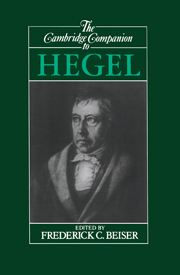Book contents
- Frontmatter
- Introduction
- 1 Hegel's intellectual development to 1807
- 2 You Can't Get There from Here
- 3 Hegel's conception of logic
- 4 Hegel's idealism
- 5 Hegel's dialectical method
- 6 Thought and being
- 7 Hegel's ethics
- 8 The basic context and structure of Hegel's Philosophy of Right
- 9 Hegel's historicism
- 10 Hegel on religion and philosophy
- 11 Hegel's aesthetics
- 12 Transformations of Hegelianism, 1805-1846
- 13 Hegel and Marxism
- 14 Hegel and analytic philosophy
- Bibliography
- Chronology
- Index
11 - Hegel's aesthetics
An overview
Published online by Cambridge University Press: 28 May 2006
- Frontmatter
- Introduction
- 1 Hegel's intellectual development to 1807
- 2 You Can't Get There from Here
- 3 Hegel's conception of logic
- 4 Hegel's idealism
- 5 Hegel's dialectical method
- 6 Thought and being
- 7 Hegel's ethics
- 8 The basic context and structure of Hegel's Philosophy of Right
- 9 Hegel's historicism
- 10 Hegel on religion and philosophy
- 11 Hegel's aesthetics
- 12 Transformations of Hegelianism, 1805-1846
- 13 Hegel and Marxism
- 14 Hegel and analytic philosophy
- Bibliography
- Chronology
- Index
Summary
When Hegel presented his lectures on aesthetics in the 1820s, he probably believed that his system of beauty and the fine arts was the most up-to-date and comprehensive of its time. And perhaps he was right. But Hegel himself would have been the first to admit that only in retrospect would a proper assessment of his theory emerge. As we now look back, Hegel's aesthetic theory stands as the product of mutually influencing currents of inquiry within German intellectual life of the early 1800s, the most salient of which was the philosophical effort to comprehend the universe within the contours of an encyclopedic, organically structured thought-system. Under the spell of this hopeful enterprise, Hegel composed his theory of art and beauty as a movement within his comprehensive metaphysical theory. Following the interpretative conventions of the time, he tacitly assumed that his readers would view his aesthetic theory as part of this greater metaphysical symphony - as a reflection and extension of his conception of a dynamic but essentially rational and harmonious universe. Although systematic, Hegel's aesthetics is not self-contained, and it solidly depends upon the presuppositions of his idealistic outlook.
- Type
- Chapter
- Information
- The Cambridge Companion to Hegel , pp. 348 - 377Publisher: Cambridge University PressPrint publication year: 1993
- 4
- Cited by

